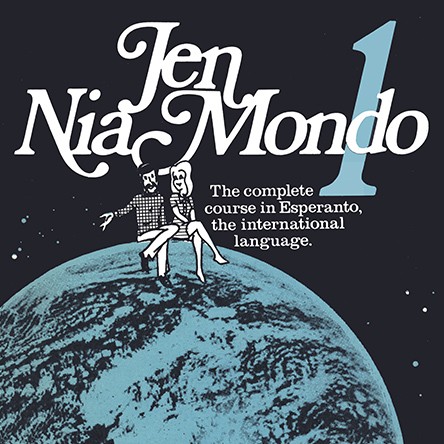
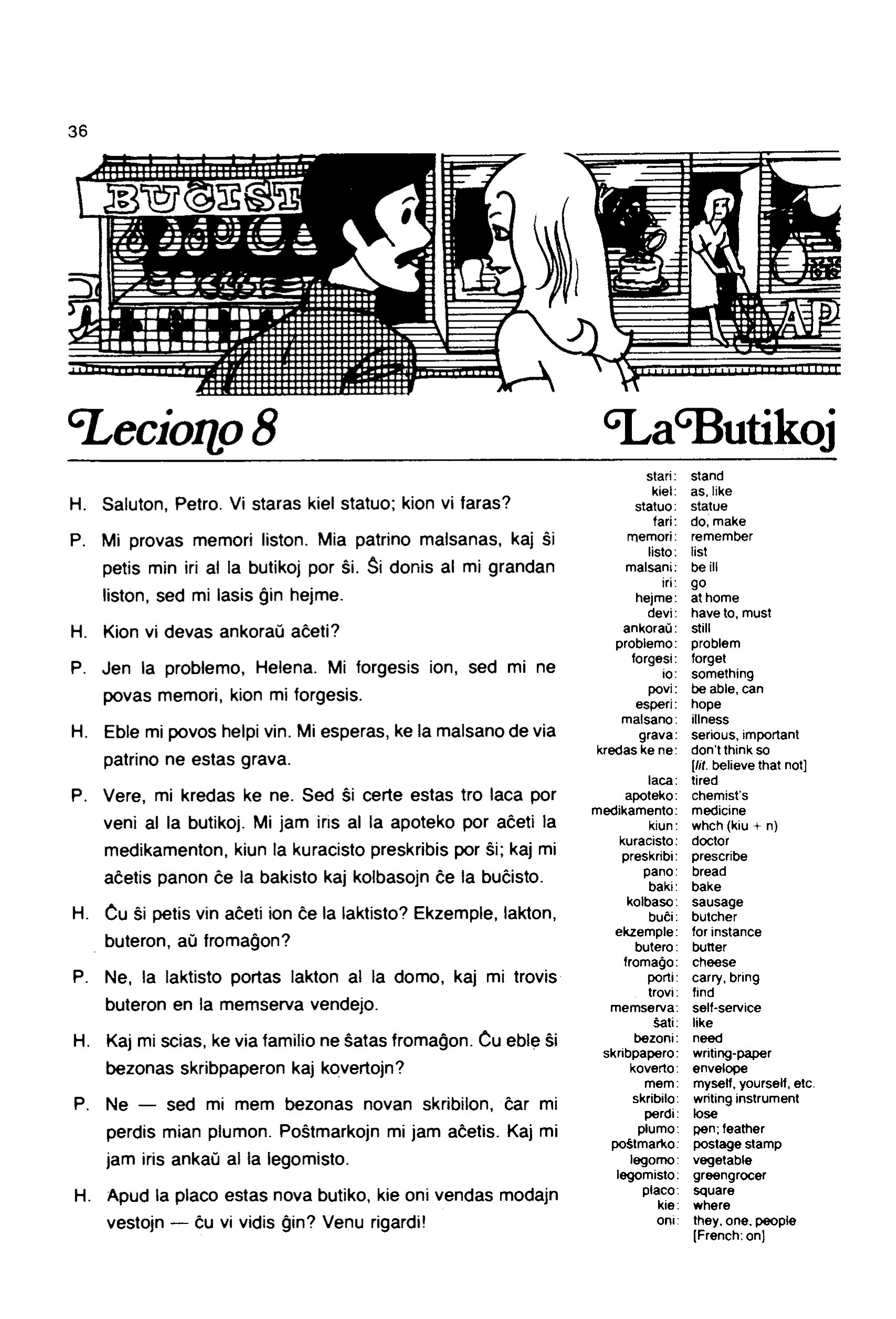
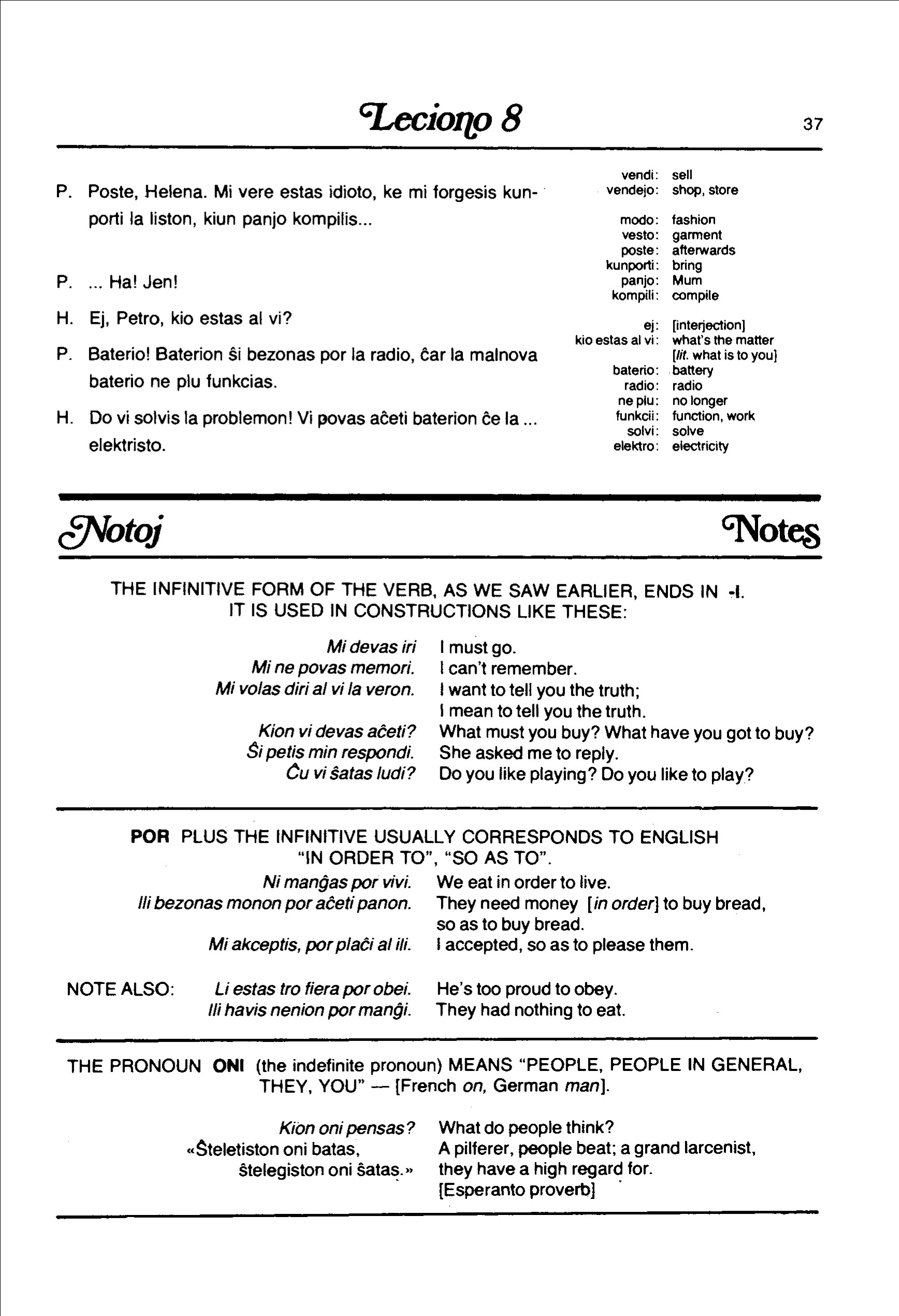
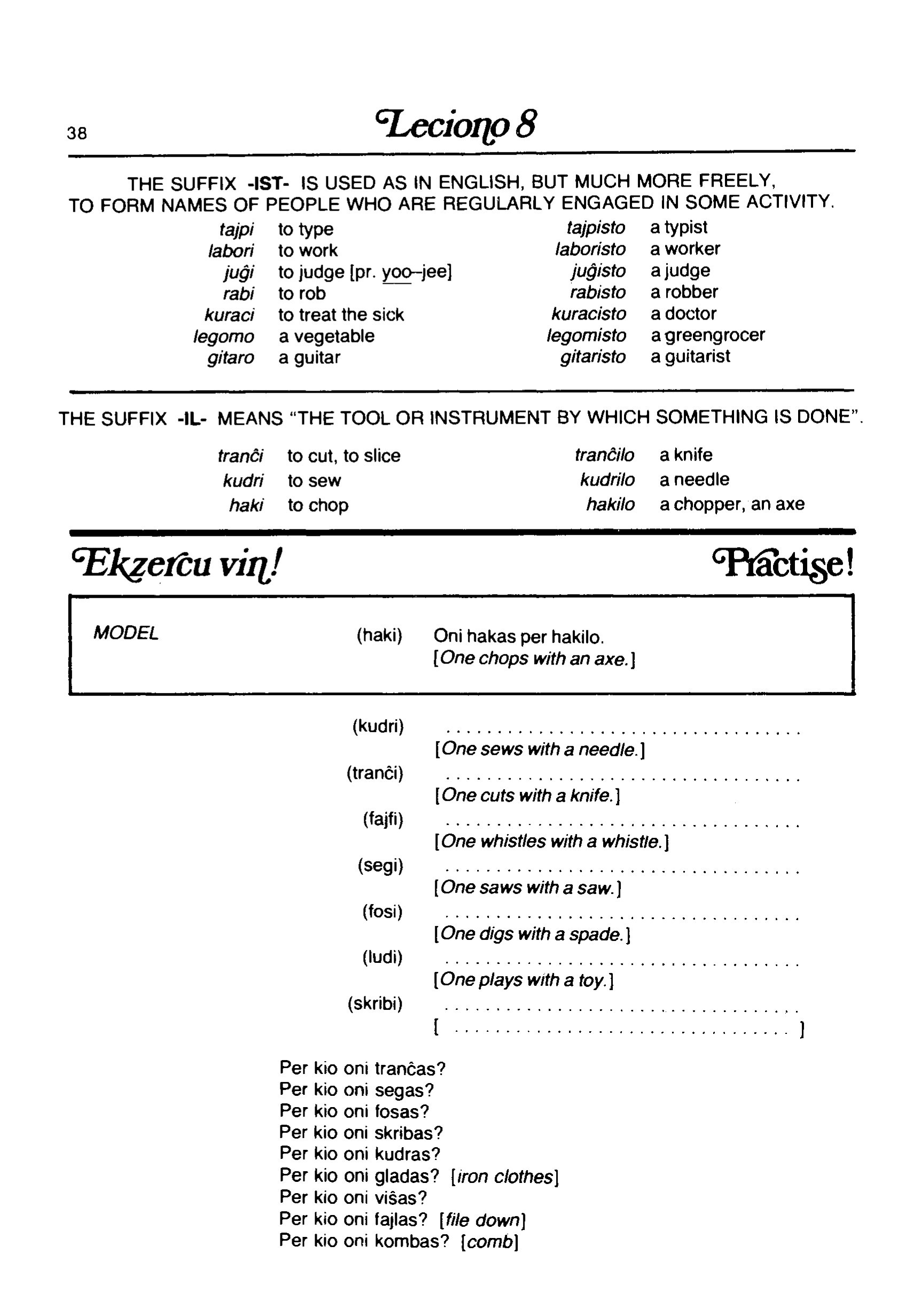
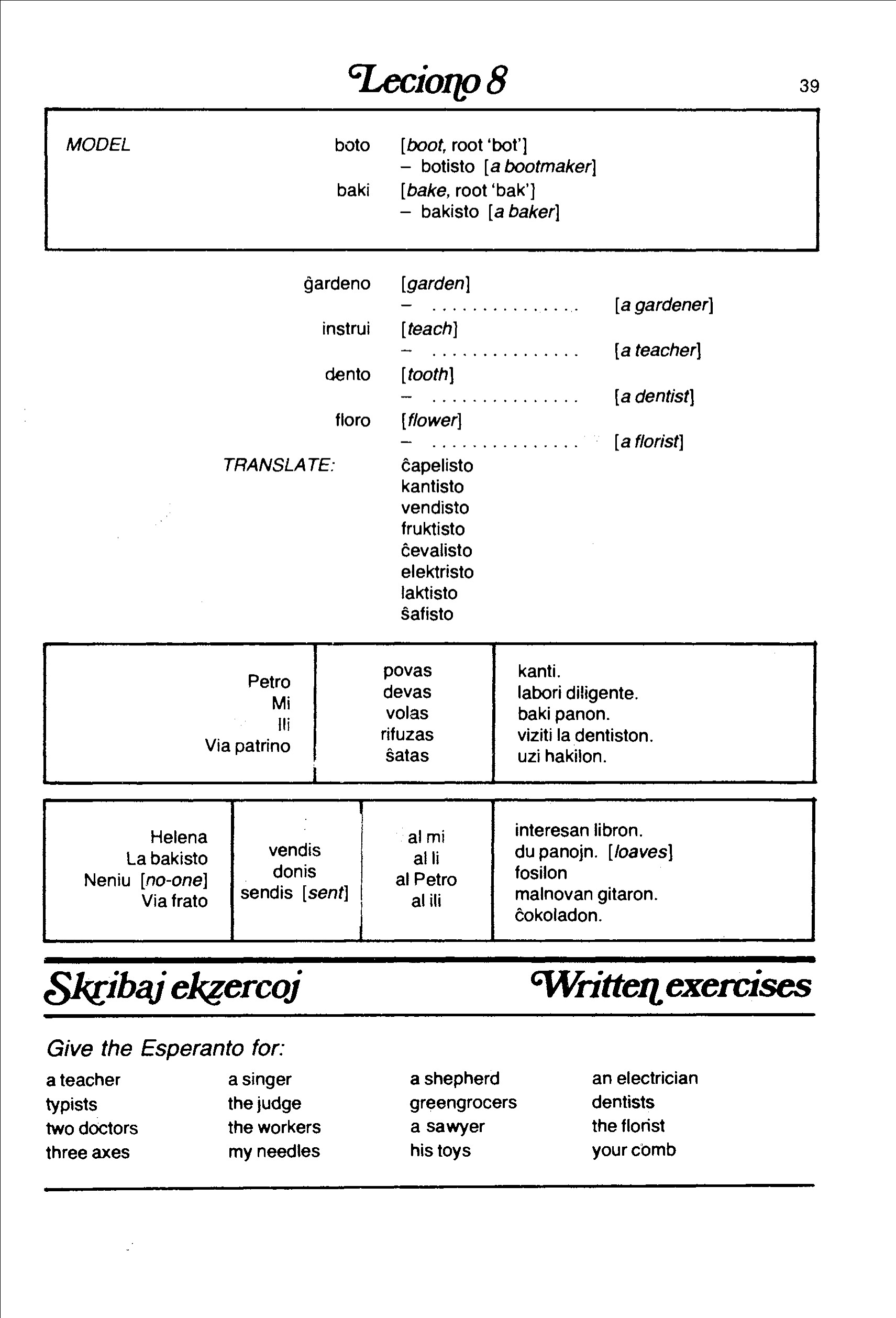
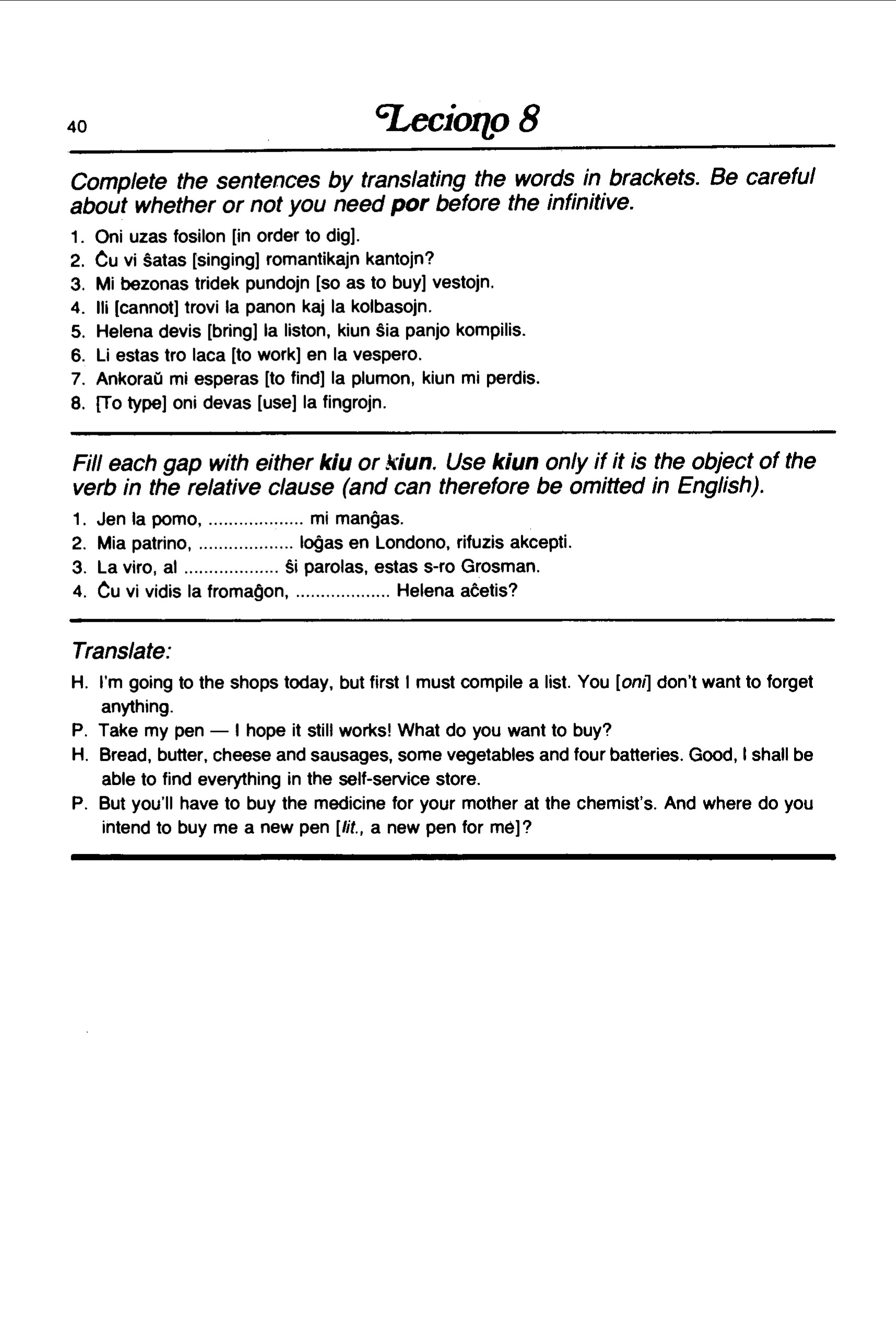

Sample Answers are offered below
Have you made some notes on points made in the dialogue, but not in the text above? For example on ‘plaĉi‘ kaj ‘ŝati‘. This is an issue that especially concerns first-language speakers of English. The content of this lesson has become rather dated, but the infinitive and vocabulary remain important. No mention of the supermarket (superbazaro) though. If you find yourself asking in what lesson did you meet a word, then check via the vocabulary list after Lesson 12,
Please attempt the exercises before consulting the material below.
Lesson 8 Answers
Page 38
Ekzercu vin! – Exercise yourself!
Oni kudras per kudrilo – One sews with a needle
Oni tranĉas per tranĉilo – One cuts with a knife
Oni fajfas per fajfilo – One whistles with a whistle
Oni segas per segilo – One sawas with a saw
Oni fosas per fosilo – One digs with a spade
Oni ludas per ludilo – One plays with a toy
Oni skribas per skribilo aŭ per plumo – One writes with a writing instrument or a pen.
Note: ‘per‘ means ‘with‘ = ‘by means of‘. You met a different word ‘kun‘ meaning ‘with’ = ‘accompanied by‘ in Lesson 1. They need to be kept distinct.
Per kio oni tranĉas? Oni tranĉas per tranĉilo
Per kio oni segas? Oni segas per segilo
Per kio oni fosas? Oni fosas per fosilo
Per kio oni skribas? Oni skribas per skribilo
Per kio oni kudras? Oni kudras per kudrilo
Per kio oni gladas [iron clothes] ? Oni kudras per gladilo
Per kio oni viŝas? Oni kudras per viŝilo
Per kio oni fajlas [file down]? Oni fajlas per fajlilo
Per kio oni kombas [comb]? Oni kudras per kombilo
Page 39
Ĝardeno [garden] – ĝardenisto – gardener
Instrui [teach] – instruisto – teacher
Dento tooth] – dentisto – dentist
Floro [flower] – floristo – florist
Ĉapelisto – a hatter : ĉapelo – hat
Kantisto – singer : kanti – to sing
Vendisto – vendor : vendi – to sell
Fruktisto – fruiter : frukto – fruit
Ĉevalisto – horseman : ĉevalo – hors
Elektristo – electrician : elektro – electric(ity)
Laktisto – milkman : lakto – milk
Ŝafisto – shepherd : ŝafo – sheep
Petro povas kanti Mi devas labori diligente Ili volas viziti la dentiston Via patrino rifuzas kanti Petro ŝatas baki panon. Mi rifuzas uzi hakilon
Helena vendis al mi interesan libron La bakisto donis al li du panojn [loaves] Neniu [no-one] sendis al mi malnovan gitaron Via frato donis al Petro fosilon.
Note: While you could say in English Helen sold me an interesting book; the baker gave him two loaves; nobody sent me an old guitar; Your brother gave Peter a spade, Esperanto never drops prepositions like ‘to’ in such expressions so that ambiguity can never arise.
Skribaj Ekzercoj
a teacher – instruisto a singer – kantisto a shepherd – ŝafisto an electrician – elektristo typists – tajpistoj the judge – la juĝisto greengrocers – legomistoj dentists – dentistoj two doctors [medics] – du kuracistoj the workers – la laboristoj a sawyer – segisto the florist – la floristo three axes – tri hakiloj my needles – miaj kudriloj his toys – liaj ludiloj your comb – via kombilo
Page 40
1, Oni uzas folion por fosi
2. Ĉu vi ŝatas kanti romantikajn kantojn?
3. Mi bezonas tridek pundojn por aĉeti vestojn
4. Ili ne povas trovi la panon kaj kolbasojn
5. Helena devis porti la liston, kiun ŝia panjo kompilis
6. Li estas tro laca por labori en la vespero.
7. Anoraŭ mi esperas trovi la plumon, kiun mi perdis
8. Por tajpi oni devas uzi la fingrojn
Note: in this context ‘por’ indicates ‘purpose’ or ‘for to’ or ‘in order to’
1. Jen la pomo, kiun mi manĝas – Here’s the apple I am eating (‘which’ omitted)
2. Mia patrino, kiu loĝas en Londono, rifuzis akcepti. My mother who lives in London refused to accept.
3. La viro, al kiu ŝi parolas, estas s-ro Grosman The man she is speaking to is Mr Grosman. (‘ to who(m) is’ omitted. Esperanto is strict about word order here. It can ‘do’ a continuous present tense but considers it not necessary, even ‘bad style’!))
4. Ĉu vi vidis la fromaĝon, kiun Helena aĉetis? Did you see the cheese Helen bought? (‘which’ omitted)
Note: Esperanto prefers to use commas to make off subordinate clauses. Contemporary English is more casual on this.
Traduku!
H. Mi iros al la butikoj hodiaŭ, sed unue mi devas kompili (fari) liston. Oni ne volas forgesi ion.
P. Prenu mian skribilon (plumon) – mi esperas, ke ĝi ankoraŭ funkcias! Kion vi volas aĉeti?
H. Panon, buteron, fromaĝon kaj kolbasojn, kelkajn legomojn kaj kvar bateriojn. Bone, mi povos trovi ĉion en la memserva vendejo.
P. Sed vi devos aĉeti la medikamenton por via patrino en la apoteko. Kaj kie vi intencas aĉeti por mi novan skribilon?
Note the difference between ‘labori’ and funkcii’
Lesson 8 Here’s a consolidated list of new words
Akcept/i
Apotek/o
Bak/i
Bat/i
Bateri/o
Bezon/i
Bot/o
Buĉ/i
Cert/e
Dent/o
Dev/i
Ekzempl/o
Elektr/o
Esper/i
Fajf/i
Fajl/i
Fier/a
Forges/i
Fos/i
Fromaĝ/o
Funkc/i
Gitar/o
Glad/i
Grav/a
Hak/i
Hejm/e
Il/o
instru/i
Io
Ir/i
Ist/o
Juĝ/i
Kiel
Komb/i
Kompil/i
Accept
Chemists, pharmacy
Bake
Beat
Battery
Need
Boot
Butcher
Certainly
Tooth cf dental
Have to, must
Example
Electricity
Hope
Whistle cf fife
File
Proud
Forget
Dig
Cheese cf fromage
Work, function
Guitar
Iron
Important
Chop
At home
Tool
Teach cf instruct
Something
Go
Regular engager in X
Judge
How, as
Comb
Compile
Kovert/o
Kudr/i
Kunport/i
Kuraci
Legom/o
List/o
Medikament/o
Mem
Memor/i
Mod/o
Neniu
Obe/i
Oni
Panj/o
Pens/i
Perd/i
Plac/o
Plu
Poŝtmark/o
Preskrib/i
Problem/o
Rab/i
Radi/o
Seg/i
Send/i
Skribpaper/o
Solv/i
Statu/o
Ŝat/i
Ŝtel/i
Tajpi
Tranĉ/i
Vest/i
Vest/o
Viv/i
Envelope
Sew
Bring
Treat the sick
Vegetable
List
Medicine
Self
Remember
Fashion
No-one, no
Obey
People, they, one
Mum
Think cf pensive
Lose
Square, plaza
Any more, further
Stamp
Prescribe
Problem
Rob
Radio
Saw
Send
Writing paper
Solve
Statue
Like
Steal
Type
Cut (as with a knife)
Clothe
Garment
Live